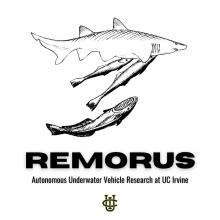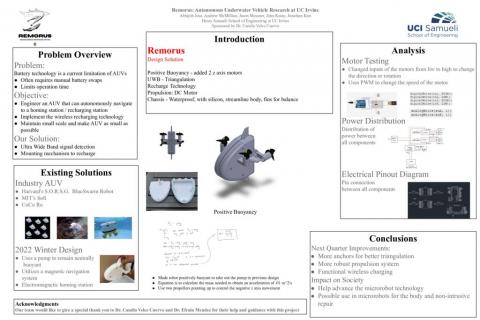World’s Smallest Autonomous Aquatic Robot for Emerging Contaminant Detection (REMORUS)
Background
For years, companies and universities have launched Autonomous Underwater Vehicles for ocean surveying, environmental monitoring, marine defense, and deep sea exploration. A limitation of current AUVs is battery technology, which often requires the robots to resurface for battery swaps therefore extending the duration of missions. Although this does increase the duration of the total mission, much of the operation time is wasted. A solution to this problem has been to create submerged recharging stations. This requires a homing and docking station to allow the robot autonomously recharge. While only a few AUVs use such technology, underwater recharging has been developed for some medium and large sized AUVs. The technology to autonomously recharge a small AUV has yet to be discovered.
Goals and Objectives
Our goal is to design a functional aquatic autonomous robot capable of finding and autonomously navigating towards a homing station. It will move three-dimensionally underwater and will navigate away from and return to the station. The big picture idea of this technology is for the AUV to be able to wirelessly recharge its battery at the station so that it can embark on another task before needing to recharge again. Last quarter (fall 2022), our goal was to find the most optimal source of navigation and propulsion for our robot. Upon research, our group chose to use a combination of ultra wideband (UWB) sensors and a magnetometer as our two sources of navigation. This quarter (winter 2023), we plan to complete testing on each component and develop a working prototype of an AUV that can autonomously navigate to a homing station.
Innovation
While there are robots in the industry that have similar functions, none of them have the complete set of functions and features that ours will have. Most autonomous underwater robots out there tend to be very large in size, while Remorus will be considerably smaller. Our robot will also use a different set of sensors than what most other AUVs, as it will use a combination of ultrasonic and magnetic sensors. This allows us to have a combination of both long range and short range sensing capabilities for obstacle avoidance and charging station navigation. While many of the AUVs produced in industry have similar capabilities, none of them will have the complete set of functions and features that ours will have. Most autonomous underwater robots, currently in use, tend to be very large in size, while Remous will be considerably smaller. Our most innovative form of technology will be using ultra wideband sensors as our main form of navigation. Sensor communication uses a wide range of frequencies to “talk” to one another. This sensor tends to have a higher precision and transmission power than other forms of wireless communication like Wifi or Bluetooth.
Link to Documentation:
https://drive.google.com/drive/folders/1p4QnvQDe4B2UtUI0eiXXwAZsYXNn0St2...
Team Contacts
Project Sponsors - Dr. Efrain Mendez (efrainmf@uci.edu) and Dr. Camilo Velez Cuervo (cvelezcu@uci.edu)
Project Lead - Jason Messner (jmessner@uci.edu)
Controls Lead - Jonathan Kim (jonatjk6@uci.edu)
Electronics Lead - John Kusto (jkusto@uci.edu)
Manufacturing Lead - Andrew McMillian (avmcmill@uci.edu)
Chassis Lead - Abhijith Jose (joseak@uci.edu)


